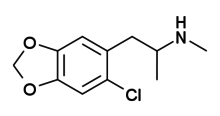6-Chloro-MDMA
6-Chloro-MDMA (6-Cl-MDMA, 2-Cl-4,5-MDMA) is a derivative of the amphetamine drug MDMA, which has been identified both in seized "ecstasy" tablets and in urine samples from drug users.[1][2] It is thought most likely to be an impurity from synthesis and its pharmacological properties have not been established, however it has been banned in several countries.
 | |
| Clinical data | |
|---|---|
| ATC code |
|
| Legal status | |
| Legal status |
|
| Identifiers | |
IUPAC name
| |
| CAS Number | |
| PubChem CID | |
| Chemical and physical data | |
| Formula | C11H14ClNO2 |
| Molar mass | 227.687 g/mol g·mol−1 |
| 3D model (JSmol) | |
SMILES
| |
InChI
| |
Legal status
6-Chloro-MDMA is illegal in the UK, Germany (Anlage I) and China.[3]
See also
References
- Lewis, Robert J.; Reed, David; Service, Adrian G.; Langford, Alan M. (2000). "The Identification of 2-Chloro-4,5-methylenedioxymethylamphetamine in an Illicit Drug Seizure". Journal of Forensic Sciences. 45 (5): 14838J. doi:10.1520/JFS14838J.
- Maresova, V.; Hampl, J.; Chundela, Z.; Zrcek, F.; Polasek, M.; Chadt, J. (2005). "The Identification of a Chlorinated MDMA". Journal of Analytical Toxicology. 29 (5): 353–358. doi:10.1093/jat/29.5.353.
- "关于印发《非药用类麻醉药品和精神药品列管办法》的通知" (in Chinese). China Food and Drug Administration. 27 September 2015. Retrieved 1 October 2015.
This article is issued from
Wikipedia.
The text is licensed under Creative
Commons - Attribution - Sharealike.
Additional terms may apply for the media files.